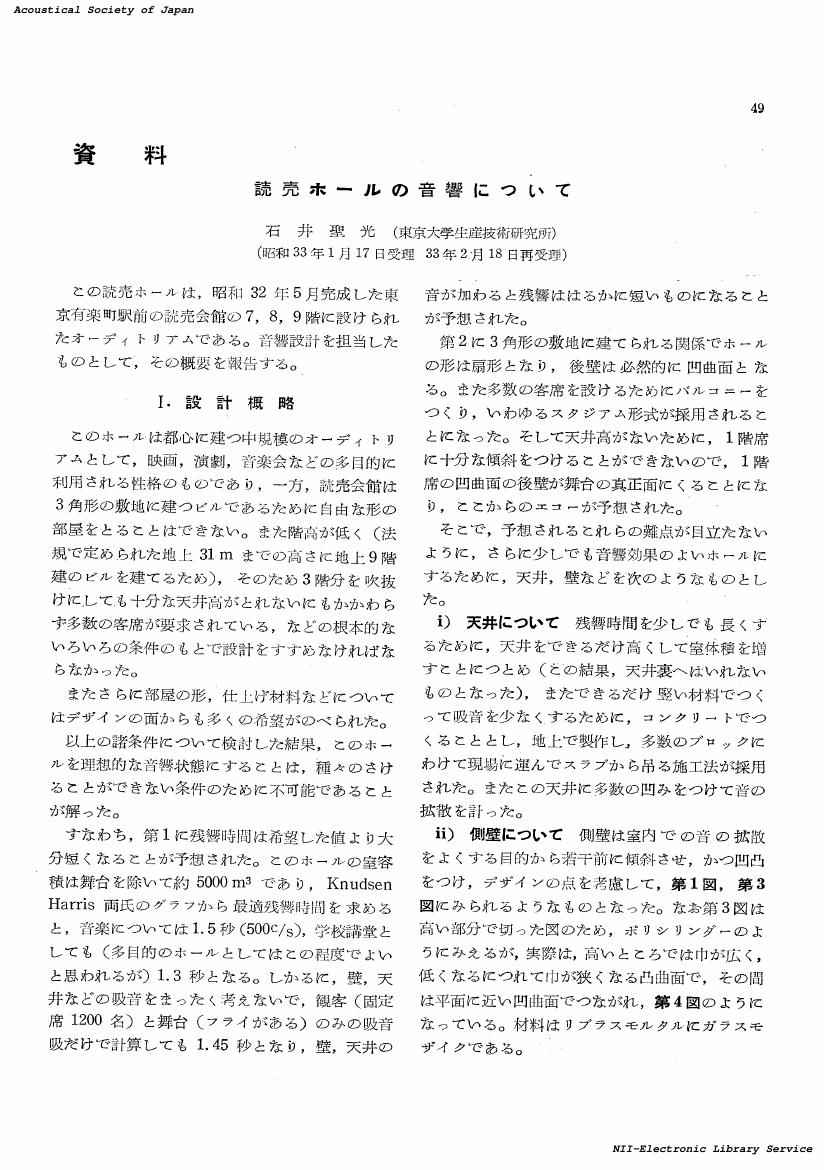5 0 0 0 2 能舞台床下の音響特性について
- 著者
- 船越 義房 石井 聖光
- 出版者
- 一般社団法人日本建築学会
- 雑誌
- 日本建築學會研究報告
- 巻号頁・発行日
- no.24, pp.251-252, 1953-10-10
2 0 0 0 OA 研究速報 : 風船の破裂音による残響時間の測定
- 著者
- 石井 聖光 平野 興彦
- 出版者
- 東京大学生産技術研究所
- 雑誌
- 生産研究 (ISSN:0037105X)
- 巻号頁・発行日
- vol.20, no.4, pp.189-191, 1968-04-01
2 0 0 0 OA 本地堂の"鳴き竜"復元に関する研究
- 著者
- 石井 聖光 平野 興彦
- 出版者
- 東京大学生産技術研究所
- 雑誌
- 生産研究 (ISSN:0037105X)
- 巻号頁・発行日
- vol.17, no.4, pp.75-81, 1965-04-01
昭和36年3月,鳴き竜で有名な日光東照宮の本地堂は火災のため焼失した.その後この重要文化財を復元する計画が進み,栃木県当局からの依頼により"鳴き竜"復元のために1/4の模型を製作して調査研究を行ない,元どおり復元できる見通しがえられた.
2 0 0 0 超低周波音・振動の生理・心理的影響と評価
1 0 0 0 OA 3018 日光東照宮の"鳴き竜"復元に関する調査研究
- 著者
- 佐藤 武夫 石井 聖光 平野 興彦
- 出版者
- 一般社団法人 日本建築学会
- 雑誌
- 日本建築学会論文報告集・号外・臨時増刊 学術講演要旨集 (ISSN:24330035)
- 巻号頁・発行日
- vol.40, pp.386, 1965 (Released:2017-08-18)
1 0 0 0 OA FDTD法による鳴き竜現象の数値解析と可聴化
- 著者
- 横田 考俊 坂本 慎一 橘 秀樹 石井 聖光
- 出版者
- 日本建築学会
- 雑誌
- 日本建築学会環境系論文集 (ISSN:13480685)
- 巻号頁・発行日
- vol.73, no.629, pp.849-856, 2008-07-30 (Released:2009-09-30)
- 参考文献数
- 27
- 被引用文献数
- 2 2
The “Honji-Do” temple located in the “Nikko Toshogu” area, in Nikko City, Japan, is famous for its strange acoustic phenomenon called “Roaring Dragon”. A dragon is painted on the ceiling of this building and we can hear a strange fluttering echo when making a handclap under the head of the dragon. The temple was unfortunately destroyed by an accidental fire in 1961 and was rebuilt in 1969. In the reconstruction work, reproduction of the “Roaring Dragon” was one of the most important items and a 1/4 acoustic scale model experiment was performed to study the reason of the acoustic phenomenon and the way of its reconstruction. In this study, numerical analyses using the finite difference time domain (FDTD) method have been performed to examine the “Roaring Dragon” phenomenon by referring the results of the scale model experiment. Furthermore, the acoustic phenomenon has been simulated in an anechoic room by applying a 3-D sound field simulation technique.
1 0 0 0 OA 読売ホールの音響について
- 著者
- 石井 聖光
- 出版者
- 一般社団法人 日本音響学会
- 雑誌
- 日本音響学会誌 (ISSN:03694232)
- 巻号頁・発行日
- vol.14, no.1, pp.49-52, 1958-03-31 (Released:2017-06-02)
- 著者
- 石井 聖光
- 出版者
- 日本建築学会
- 雑誌
- 日本建築学会論文報告集 (ISSN:03871185)
- 巻号頁・発行日
- vol.103, 1964
1 0 0 0 IR 日生劇場の音響について
- 著者
- 石井 聖光 平野 興彦
- 出版者
- 東京大学生産技術研究所
- 雑誌
- 生産研究 (ISSN:0037105X)
- 巻号頁・発行日
- vol.16, no.2, pp.31-35, 1964-02
昨年10月20日,ベルリンオペラでフタを開けた日生劇場は芸術院会員村野藤吾氏の設計になるもので,われわれはその設計施工に当たり,音響の立場から参加し,1/10の模型を製作して,その形状を検討し,設計者の芸術的なデザインをそこなうことなく,音響効果を上げるべく努力を重ねた.本報告は,その経過の概要である.
1 0 0 0 道路交通騒音予測計算方法に関する研究-1-実用的な計算式について
- 著者
- 石井 聖光
- 出版者
- 一般社団法人日本音響学会
- 雑誌
- 日本音響学会誌 (ISSN:03694232)
- 巻号頁・発行日
- vol.31, no.8, pp.p507-517, 1975-08
- 被引用文献数
- 36 20
1 0 0 0 IR 風船の破裂音による残響時間の測定
- 著者
- 石井 聖光 平野 興彦
- 出版者
- 東京大学生産技術研究所
- 雑誌
- 生産研究 (ISSN:0037105X)
- 巻号頁・発行日
- vol.20, no.4, pp.189-191, 1968-04
1 0 0 0 神奈川県立音楽堂の音響について
- 著者
- 渡辺 要 石井 聖光 木村 翔
- 出版者
- 一般社団法人日本建築学会
- 雑誌
- 建築雑誌 (ISSN:00038555)
- 巻号頁・発行日
- vol.70, no.819, pp.10-17, 1955-02-20
1 0 0 0 OA 研究速報 : 窒素を媒質とする音響模型実験の研究
- 著者
- 石井 聖光 平野 興彦 橘 秀樹
- 出版者
- 東京大学生産技術研究所
- 雑誌
- 生産研究 (ISSN:0037105X)
- 巻号頁・発行日
- vol.20, no.7, pp.379-380, 1968-07-01
1 0 0 0 騒音の広域伝搬性状に関する研究
1 0 0 0 建物構造体中における固体音の伝搬性状
- 著者
- 松田 由利 橘 秀樹 石井 聖光
- 出版者
- 一般社団法人日本音響学会
- 雑誌
- 日本音響学会誌 (ISSN:03694232)
- 巻号頁・発行日
- vol.35, no.11, pp.609-615, 1979-11-01
- 被引用文献数
- 33
The propagation characteristics of solid-borne sound in building structures are studied by field measurements on three standing buildings and scale model experiments using a simplified building structure. Both in the field measurements and the scale model experiments, vibration acceleration levels(V. A. L. )at a number of widely distributed points in the structures are measured as one point of the structure is excited. From the results of the scale model experiments, it is revealed that the relative V. A. L. at any point is determined by its distance(r)from the excitation point via the shortest route in the structure, regardless of the propagating direction. It is assumed that the variation of V. A. L. (L_r)in buildings can be expressed as, L_r=P_0-Nlog r-Mr(P_0 depends on the strength of excitation)and the value N and M are examined from the results of measurements. From the results of the scale model experiments, the value of N is determined to be 20, regardless of frequency. Using this value, the M value in each octave band is determined from the results of the measurements taken on the standing buildings. The result shows that the M value is approximately proportional to the square root of the frequency.

